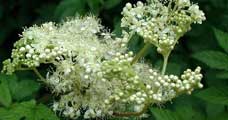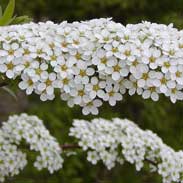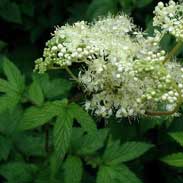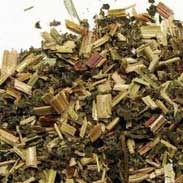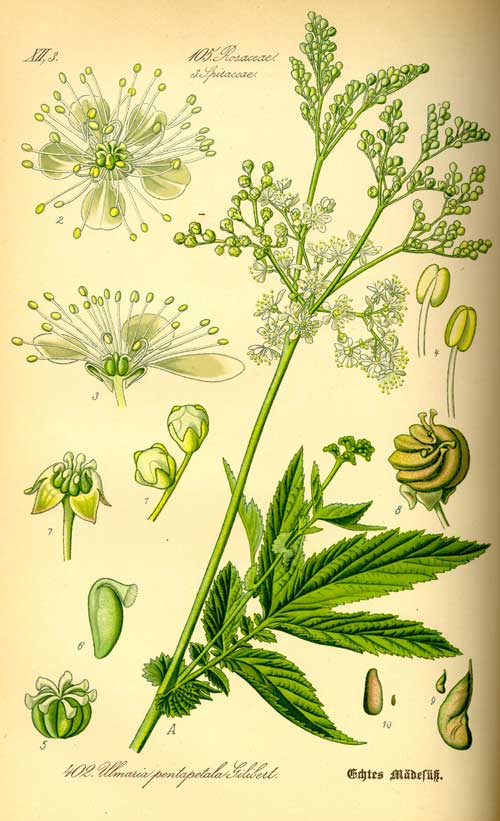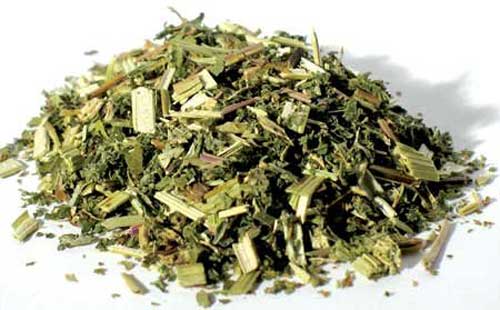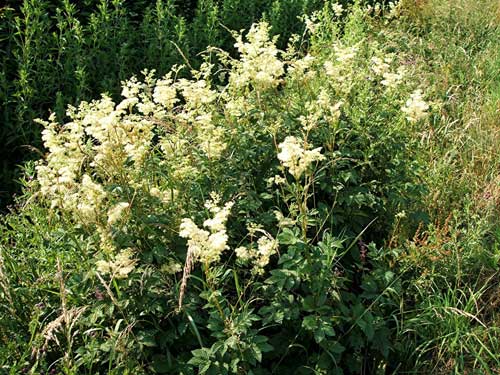
|
|
||||
| Our Pages ABOUT CONSTITUTIONAL MEDICINE
|
Meadowsweet is a long lived (perennial) herb that likes to grow in damp meadows and is native to both Europe and Asia. In herbal medicine both the leaves and flowers are used, and both have a characteristic strong and sweet-smelling scent.
Meadowsweet has long been used to help soothe and heal damage to the gut wall. Widely used as a tea and especially seen to help calm down an overactive digestive system. Meadowsweet also has a traditional reputation for treating urinary stones, rheumatism, liver disorders and bad breath, more recently, it has been adopted for the treatment of reflux or gastric ulcers. It is interesting to note that salicylic acid was first isolated from Meadowsweet in 1869. A compound that was later synthesised to develop aspirin. Taking too much aspirin for too long can cause ulcers in the gut, but ulcers are exactly one of the main things that Meadowsweet has been long used to treat, prevent or even cure. Whilst Meadowsweet clearly has some anti-inflammatory effects (likely due to a combination of compounds) the presence of tannins and other constituents in the plant prevent any possible damage to the gut lining from ingredients such as its salicylate content. As Andrew Chevallier writes 'Meadowsweet clearly illustrates the fact that herbal medicines cannot be understood by considering their constituents in isolation' The eclectic physicians of the 18th and 19th centuries considered Meadowsweet an 'excellent astringent to diarrhoea, less offensive to the stomach than other agents of its kind'. They also widely prescribed it for menstrual cramps and genito-urinary tract infections. Maude Grieves writes 'it is a valuable medicine in diarrhoea, almost a specific in children's diarrhoea, imparting to the bowels some degree of nourishment as well as of astringency, it is also considered a good corrector of the stomach and is frequently used in affections of the blood' David Hoffmann writes 'Meadowsweet is one of the best digestive remedies available. As such, it will be indicated in many conditions, if they are approached holistically. The herb protects and soothes the mucous membranes of the digestive tract, reducing excess acidity and easing nausea. It is used in the treatment of heartburn, hyperacidity, gastritis, and peptic ulceration. Its gentle astringency is especially helpful in children's diarrhoea. The presence of aspirin-like chemicals (salicylates) explains Meadowsweet's ability to reduce fever and relieve the pain of rheumatism in muscles and joints' Thomas Bartram writes that Meadowsweet's actions are 'antacid, stomachic, astringent, antiseptic, diaphoretic, diuretic, hepatic, anti-inflammatory and mild urinary analgesic'. Bartram suggests it may be used for effective symptomatic relief of indigestion and other upper gastro-intestinal conditions associated with excess wind and hyperacidity. Gastric ulcer, gastric reflux, liver disorders, summer diarrhoea in children, cystitis, chronic rheumatism, oedema and urinary stones' and that it 'combines well with Golden Seal and Marshmallow root for gastric ulcer' Bartram suggests doses of 1-2 tsps of the dried herb in a cup of boiling water infused for 10-15 minutes, and smaller doses for the children and the elderly. The British Herbal Pharmacopoeia (BHP) describes Meadowsweet's actions as stomachic, antirheumatic, urinary antiseptic, astringent & antacid and says it is indicated for atonic dyspepsia with heartburn & hyperacidity, acute catarrhal cystitis, rheumatic muscle & joint pains, diarrhoea of children and specifically indicated for peptic ulcer, used for prophylaxis & treatment. The BHP suggests a dose of 4-6 gms, or by infusion, and recommends a tincture in the ratio of 1:5 in 45% ethanol with a dose of 2-4mls. The meadowsweet is one of the best-known wildflowers; its virtues have been known since the time of Dioscorides. The fragrant creamy white flowers have an almond scent of which Gerard writes 'for the smell thereof makes the heart merrie and joyful and delighteth the senses' The flowers are certainly lovely and have obviously been highly appreciated over the centuries for their beauty as well as their scent. One of Meadowsweet’s other common names, Bridewort, came both from it being used to make bridal garlands and also from the custom of strewing the herb on the floor for festivals and weddings. Another of its common names, Queen of the Meadow, comes from the way its flowers can pop up and dominate over a low-lying meadow.
~ Meadowsweet was used in an ointment for 48 women with cervical dysplasia. A complete remission was recorded in 25 cases and a positive response in 32 women in all. No recurrence was observed in 10 of the women after 12 months. The study does not say how long they used the ointment for (Peresun'ko AP, Bespalov VG, Limarenko AI et al. Vopr Onkol 1993;39(7-12):291-295) ~ When studied in the laboratory Meadowsweet demonstrates a strong and active chemistry that acts on pathways of inflammation and immune system health and this has been suggested as the reason it has developed a reputation for the treatment of inflammatory diseases (Halkes SBA, Beukelman CJ, Kroes BH et al. Phytother Res 1998; 11:518-520) ~ An anticoagulant activity for extracts of Meadowsweet flowers has been demonstrated, which is thought to be due to a heparin-like substance in the plant (Kudryashov BA, Lyapina LA, Konfsshevskaya VM et al. Vestn Moskovskogo Universiteta Seriya Xvi Biologiya 1994;(3):15-17) ~ Laboratory studies have shown that Meadowsweet has potent antimicrobial actions against an array of common sources of infection: Sthaphylococcus aureus haemolyticus, Streptococcus pyogenes haemolyticus, Escherichia coli, Shigella flexneri, Klebsiella pneumoniae and Bacillus subtilis. (Csedo K, Monea M, Sabau M et al. Planta Med 1993;59(suppl 7):A675) ~ The authors, titles and the 'where-and-when' published of nearly 20 further studies and articles on Meadowsweet are listed in a PDF found here
For some years now, against this proven and safe way of herbalism, there has been a rising tide of excessive caution and scare-mongering in many parts of the world. The same authorities that, not so long ago, decried herbal medicines as ineffectual, have now taken up a different adversarial position; that they are dangerous substances that should only be prescribed by Doctors, who of course have zero training in them. Unfortunately, the same unnecessary fear and worry has crept into many natural health websites and popular publications on herbs. Herbs that we have safely used for thousands of years, that have no reports of adverse reactions in the medical literature despite widespread use by millions of people, are suddenly described as contraindicated because of something that should have been seen as completely unimportant, or at the utmost a merely theoretical concern, such as a laboratory study on one of the herb's constituents to use an all too common example. I wonder sometimes if the writers of such articles feel that the herb will be more deserving of respect if it is thought to be a little bit dangerous, in other words more like a drug than something that has simply come out of the earth and been used by ordinary people for generations beyond count. There is just so much misinformation about herbal medicine on the internet now. Ludicrous claims and cautions abound in equal measure; it seems like one group are trying to make money out of the public whilst the other are busily trying to scare them off. I have to believe that the kind of reader who takes the time to read pages on herbs that are as extensive as this one is much less likely to be swayed by marketers or misinformers. I hope that you will keep your wits about you if you get conflicting opinions from people who have never really got to know these herbs, who have never worked with them, or learned how to use them safely and effectively. I want to remind you that the reason that herbs can never be patented and owned by any individual or corporation is because they are, and always will be, the People's medicine. They belong to all of us and it is my great hope in sharing this work that you will learn how to use them wisely for yourself, and the people you care for. Be safe, but do not be afraid.
Meadowsweet is clearly one of the best herbs for an over-acidic stomach and, especially if people are getting some acidic taste come into their mouths, or are getting frequent bouts of ‘heartburn’, then Meadowsweet can work very quickly to provide therapeutic relief. Meadowsweet is a safe herb to take in high doses when needed. If I am using Meadowsweet in a formula to treat acute gastritis or some other kind of active indigestion, then I will generally give a dose range of between 1 to 3 mls of it at a time and will be prepared to use it up as much as needed, even up to 5 or 6 times a day if this is what is required to rapidly turn things around. A lower grade, more chronic condition may be better treated with just a once, twice, or three times a day dose. I am in the common practice of using a combination of Licorice root, Catnip and Fennel seed for acute gastritis, but Meadowsweet can be given to those who cannot take Licorice or it could well be added as an adjunct to those three well-used herbs (the write up on the 'Gastritis formula' and how to use it, is found here Another excellent way to use Meadowsweet in a tea for heartburn, gas, indigestion etc. is to combine it with equal parts along with Chamomile, Fennel and Caraway seed. This combination makes a pleasant and rapidly effective tea that can be used as often as needed. There is a write up on the 'GI tea' that contains these three herbs here, and all you would need to do is to add one heaped tsp of Meadowsweet to that recipe, each time you made a pot of tea. When I take some Meadowsweet with an open and quiet mind, then I can understand why it has been so well rated as a digestive remedy for acidity and over-activity. Meadowsweet has a marked action to it that feels like it is gently 'coating’ your mouth and tongue and it no doubt gives the same kind of protective wrapping around a tender stomach lining or an agitated bowel! If you who are reading this are studying herbal medicine or have your own reasons to want to get to know this plant ally much more deeply then I urge you to do the same experiment for yourself, whereby drinking a cup of Meadowsweet, or taking a dose of its tincture, with a quiet and attentive mind may do more to help you truly understand its 'action' than any amount of an academic study of the plant! Further to this, if you would like to learn more about the ancient art of pulse testing, a simple but powerful way to ask the intuitive intelligence of the body for its responses to a herb by feeling the pulse whilst giving a tiny dose by mouth, read here
Much of the information here about the traditional uses of Meadowsweet is consistent with the model of thinking whereby one may treat problem A with plant B. There is value in this approach, especially in how it helps us pass on useful knowledge to one another, but it falls short in one vital area; and that is that people are not all cut from the same cloth! Something that works brilliantly for one person may do less for another -- why is this? Part of the reason is that people vary in their constitutions as to whether they are either hotter or cooler and, at the same time, either dryer or damper. This useful and rather fascinating subject is introduced further here Another big part of using the right herb when it is most needed comes from understanding the need to treat what is going wrong for the person that had led up to their getting a health condition. In this light, Meadowsweet can particularly offer its benefits when a relaxing action is needed in the 'cycle of healing', more about this here
Please understand that I cannot advise you, including on products or dosage, without seeing you in person in my clinic but for ideas
on how you might find a good herbalist in your area read here |
|
|
|
© 2011 R.J.Whelan Ltd
